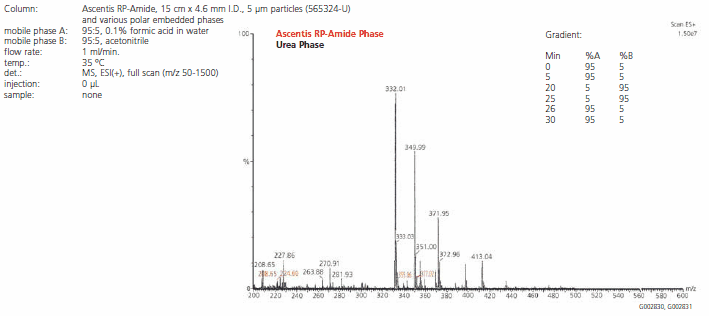Mass Spectral Column Bleed in Nitrogen-Containing Polar-Embedded HPLC Stationary Phases
Carmen T. Santasania, David S. Bell
Reporter EU Volume 16
Introduction
Liquid chromatography-mass spectrometry has become one of the most important tools in the analytical chemistry laboratory over the past decade. The structural information obtainable along with sensitive detection has made the technique indispensable in pharmaceutical, environmental and a wealth of other scientific disciplines.
HPLC column bleed is a major source of background signal in LC-MS analyses. This phase bleed occurs when the bonded phase elutes from the column during the analysis. The bleed may originate from acid hydrolysis of the bonded phase at low mobile phase pH values or from dissolution of the silica substrate under more basic conditions. Most column manufacturers recommend using silica-based columns between pH 2 and 7.5, however, hydrolysis of C18 phase may occur using mobile phases at pH 2-3 and slow dissolution of the silica substrates occurs in the commonly used pH range.
In this report, we examine the extent of stationary phase bleed for several commercially available, nitrogencontaining polar-embedded phases. The study utilizes a low pH mobile phase to enduce hydrolysis of the bonded phase along with gradient elution to ensure elution of any liberated phase material. Prior to analysis, each of the columns used in this study were exhaustively washed and stored in 50:50 methanol: water for two days. This procedure reduces the probability of observing bleed from sources other than that due to stationary phase instability.
Experimental
Bleed analyses were performed on a Waters® (Milford, MA USA) 2795 HPLC system coupled to a Waters Micromass ZQ mass spectrometer via an electrospray interface. The interface was operated in positive ion mode and an m/z range of 50 to 1500 was acquired.
Acetonitrile and water were of LC-MS grade. Formic acid obtained from the same supplier was of HPLC grade. Prior to each column bleed analysis, a blank run using no column in line was acquired to establish responses due to system impurities. Each column was subsequently subjected to five gradient cycles. HPLC conditions are shown in Figure A.

Figure A.Accumulated Mass Spectra for Ascentis™ RP-Amide and Urea Polar Embedded Stationary Phases (565324-U)
Results and Discussion
The information-rich LC-MS experiments are difficult to present in their entirety. For brevity, the combined mass spectra for each run were obtained by accumulating the spectra over the time range of 14-16 minutes. It is in this time frame where the greatest concentration of mass responses due to phase bleed is observed. In addition, the spectral responses in this report are presented in the range of m/z 200-600. Presentation of the data in this range avoids complications due to abundant mass responses at low m/z ranges originating from system contamination. The mass spectrum obtained using the Ascentis RP-Amide stationary phase is compared to the urea polar-embedded phase response in Figure A.
The Ascentis RP-Amide spectrum demonstrates a limited number of mass responses due to column bleed in this region. Table 1 lists the significant mass responses that were not observed in blank runs for the Ascentis RP-Amide column and several commercially available amide, carbamate, and urea polar-embedded phases. The Ascentis RP-Amide phase exhibits three minor mass responses that can be attributed to stationary phase bleed (m/z 355, 359 and 377). The analysis from a commercially available urea polar-embedded phase shows numerous intense mass responses in the investigated region, indicating substantial bleed. For the carbamate phase, the mass responses are significantly lower in intensity than the urea column; however, there are additional mass responses that may be attributed to phase bleed. This increases the probability of analyte interference by phase bleed that may lead to increased difficulty in spectral interpretation. A second commercially available amide phase exhibits the same number of mass responses as the Ascentis RP-Amide, however, there is a significant increase in response intensity resulting in higher background.
Conclusions
In this study we have examined LC-MS bleed characteristics of nitrogen-containing polar-embedded stationary phases. The results demonstrate that the Ascentis RP-Amide phase exhibits fewer and less intense mass spectral bleed responses when compared to other commercially available polar-embedded columns. Low stationary phase bleed results in improved detection of trace impurities, facilitates mass spectral interpretation, and minimizes downtime due to source contamination.
如要继续阅读,请登录或创建帐户。
暂无帐户?